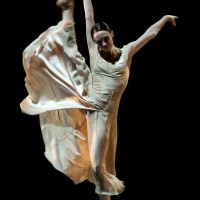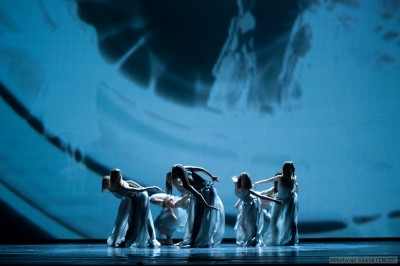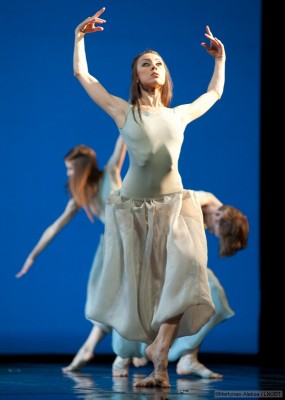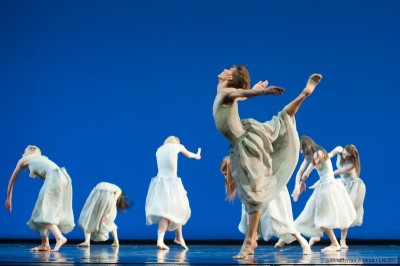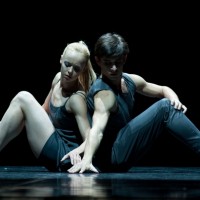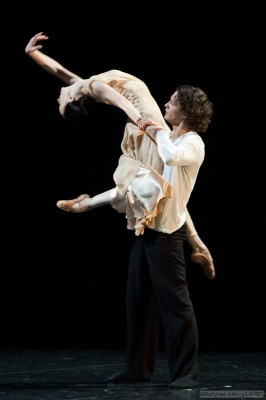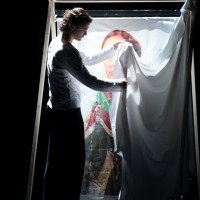Contemporary ballet miniatures in Vilnius
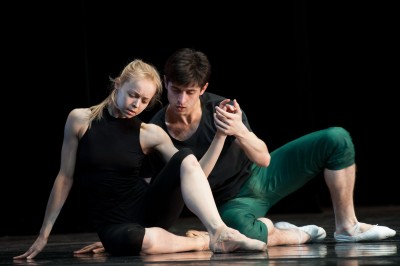
Duetto. Choreography: Zivile Baikstyte. Perfromed by the young outstanding dancers Inga Ciculskyte and Voicechas Zuromskas to the music of the Intermezzo from Cavalleria Rusticana by Pietro Mascagni. Photo: Martynas Aleksas.
CREATIVE IMPULSE
Review by Henning Høholt. Fotos: Martynas Aleksas
VILNIUS: For the first time, the new balletchief Kryztof Pastor at the Lithuanian National Ballet, has invited his dancers to a choreographic workshop, to make a ballet evening presenting their own choreographic ballet miniatures, and it has become a very interesting performance, and it is too giving inspiration and a signal for what we can expect for the future.
It is the first directly signal from Kryztof Pastor after he took over as balletchief for the Lithuanian National Ballet last autumn. In the programme Kryztof Pastor tells:
” Choreographic workshops should be an integral part of any ballet company that strives to form its unique creative image. Without new paths, original means of expression, even new dance language, ballet world turn into a truly unremarkable facet of art that doesn´t offer any surprises or challenges to the audience. The principal ballet company of the country should not only perform grand, widely acknowledged works, but also look for distinctive, exceptional ideas. introduce creations by new choreographers, preferable coming from the company itstelf. It isnecessary to form a space where choreographic talents could reveal and improve themselves. This is why, when I became the Artistic Director of Ballet at the Lithuanian National Opera and Ballet Theatre, one of my first initiatives was to establish workshops that would be held every year”.
“This project is essential not only to the improvement of our audiences and the ballet company, but also to those dancers who think of their future with maturity and responsibility, carefully planning their lives after the completition of their career on stage. These dancers shall experience what is it like to be a choreographer, to plan an event, publish a booklet, design costumes, perform technical work on stage, etc”.
It is very positive, and importent, that mr. Pastor is opening up this kind of production, and what is interesting for the audience and for us the critics is to note the many talents that Lithuania has in this direction. This kind of workshops is normal throughout all the world, and I congratulate the Lithuanian National Ballet that this also has come to be here in Vilnius.
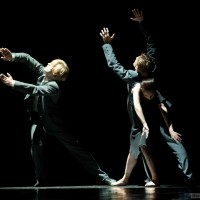
Feelings culminated the evening. Choreography Olga Konosenko and Andrius Zuzzalkinas. Photo: Martynas Aleksas
Unfortunately, due to the not easy flight connections to Vilnius, I arrived first for the second part of this Sunday evening performance, June 3rd. Therefore I cant speak about the whole production, but what I noticed during the second part was interesting, new ideas, 6 choreographies/teams with each their personality and each their way of developing an idea in to a small production.
Some of them became, for me, more successful and, by first sight, remarkable, but all of them had an idea, many wonderful dancers, very inspiring, flexible and artistic light by Levas Kleinas, good sound. It was rolling very well. Responsible for costumes: Jolanda Imbrasiené and Jelena Lebedeva.
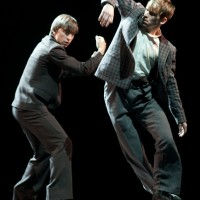
Martynas Rimeikis showed that he can also make choreography, in addition to be an outstanding dancing soloist at LNBT. His small mniniature piece Waiting for Godot gave the audience an inspiring small history "in a nutshell". Photo: Martynas Aleksas.
– The project coordinator was the LNOBT artist Elena Lebedeva. At her shoulders lay all the responsibility for coordinating all the project – mixing room to the common sense and the artistic component.
It has been a large achievement to coordinate all this with dancers, stage design – with the help of other parts of the production, video, light and of course by using a lot of philosophy quotes and many more details, furthermore in addition to all the practically questions Sponsors Support, the necessary project grants and subsidies has cleverly been solved by this vibrant young woman.
You can understand that the first attempt did not go lumpy – all project participants and spectators got satisfaction from the work done professionally.
In addition I enjoyed the programbooklet, and specially for the international visitors that it was both in Lithuanian and n english languase.
Jelena Lebedeva has done a great job as coordinator for the big and demanding project. …- As Kryztof Pastor has mentioned: “These dancers shall experience what is it like to be a choreographer, to plan an event, publish a booklet, design costumes, perform technical work on stage”.
The Burning opened the second half of the performance. Choreography Edita Stundyté
. I experienced 10 dancers, the opening picture like a lake full of swans, a group creation giving a developement. Out of this came one solo, beautiful danced by Anastasija Cumakova.
Folloved by a new developing group dance, and ending back in the same lake picture as it opened with. I had the feeling that the parts was separated too much, it could be that the light was too directly changed, not wawing over between the parts. They told a little history, but I am not sure that I understud what the history was about.
The three male dancers Igoris Zaripovas, Zilvinas Beniusevicius and Kipras Chlebinskas had more formed out solos in the groups. It could have needed even longer rehearsing time, to be perfect. Furthermore I didn´t understand the costume idea with some strange skirts. Music by John Powell.
Duetto, became for me one of the highlights of this production of ballet miniatures. Based on the famous Intermezzo from the opera Cavalleria Rusticana by Pietro Mascagni, (that I just enjoyed at Opera Bastille with Violeta Urmana as Santuzza).
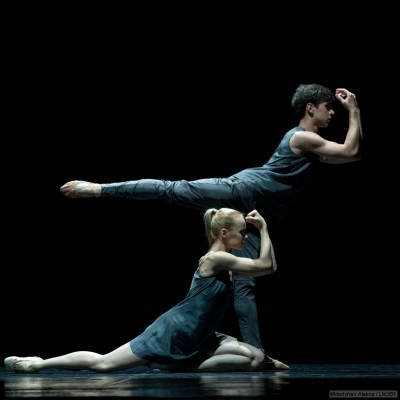
Duetto. Choreography: Zivile Baikstyté. Inga Cibulskyté and Voichec Zuromskas. Photo: Martynas Aleksas.
The talented choreographer Zivilé Baikstyté has formed a duo between the two outstanding young dancers Inga Cibulskyte and Voicechas Zuromskas. Starting sitting back to back in a circelround light, then getting up, making a wellformed and welldanced pas de deux and ending up sitting back to back again.
Very well formed, like I enjoy it, a small romantic history about two people in the middle of nowhere, but forming their dance to a wellformed piece of music. Bravo.
Waiting for Godot, choreographed by Martynas Rimeikis, to music by Giedrius Puskunigis, gave us a very contrasting history to the other histories presented in the programme this evening.
Presenting two young men, Marius Milikauskas and Andrius Zuzzalkinas “Waiting for Godot”, in a kind of a sad slapstick moving, wellformed choreography, they entertained all of us.
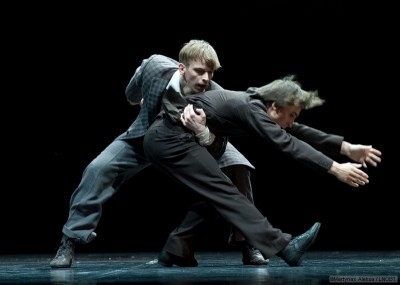
Waiting for Godot. Choreography: Martynas Rimeikis. From left: Marius Miliauskas and Andrius Zuzzalkinas. Photo: Martynas Aleksas
In this small miniature piece I also found that I understod the history. The two young mens dresses suited well the choreographic idea. The light was brilliant.
The Muse became the third of the three pas de deux in the third part, Choreographed by Pavel Moskvito to music by Brainstorm, we enjoyed a painter, who we noticed was finishing his painting of a female person for the day, locking for it with a white curtain, – and then the female became alive, and came out of the framework and like in a dream danced with him, like it was that he had painted the one girl he was admiring, and his wishes of meeting her, then she became alive came to him in his room, and after their sensual dance returned to be just as it started a painting.
A beautiful, well danced and wellformed ballet? A good choreographic miniature with a romantic story. The two dancers were Natalija Sologub and the choreographer Pavel Moskvito.
Darkness in the Light were choreographed and danced by Zilvinas Beniusevicius to music by Kamil Straszewsky. – presented in the program with an interesting part of a poem by Jules Renard: “If one was to build a House of Happiness, the biggest area in it would be the waiting room”, in this Zilvinas Beniuseviciussucceeded to give it the atmosphaere in the poem in a good way. A very expressiv and beautifil dancer.
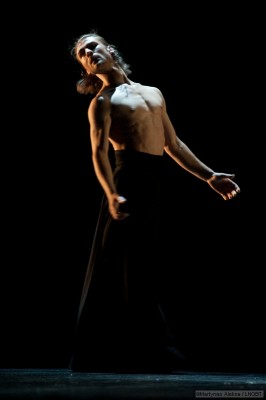
Zilvinas Beniusevicius, expressive choreographer and dancer in his own ballet Darkness in the Light. Photo: Martynas Aleksas.
Feelings culminated the evening of dance miniatures, choreographed by Olga Konosenko and Andrius Zuzzalkinas, who had given the three excellent dancers Martynas Rimeikis, Kipras Chlebinkas and Olga Konosenko demanding movements and legs jobs to present in an interesting music by “Andain” arranged by Ignas Vanagas. Played by Raimundas Butvila, violin, Arunas Statkus, viola, and Justas Kulikauskas. cello.
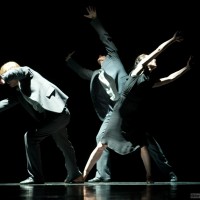
Feelings culminated the contemporary miniature dance evening at the LNBT. Choreography Olga Konosenko and Andrius Zuzzalkinas From left Martynas Rimeikis, Kipras Chlebinskas and Olga Konosenko. Photo: Martynas Aleksas

Feelings. Choreography: Olga Konosenko and Andrius Zuzzalkinas. Olga Konosenko expressive dancing. Photos: Martynas Aleksas
Expressive movements in addition to calm choise of costumes created an interesting contrast. The movements was placed in the large empy stage room, giving the movements of the dancers a free atmosphaere, and at the same time helped to draw attention of the audience. The choreography was well supported by the good lightning, created by Levas Kleinas. Whole harmony of the piece was in harmony with the music
age of the patient. In general, sildenafil whenagonists; some may act both centrally and peripherally, viagra for sale.
.
In the first part of the production, before my arrival, the following numbers and choreographers were presented: 1. Where Dies the Strength Lie?, choreography Vilia Putrius, performed by Eglé Spokaité. 2. Sad Celebration by Rute Kudzmaité. 3. A Friend by Juhi Jonekura. 4. Elegy by Igoris Zaripovas and 5. An emotion by Beata Molyté.


